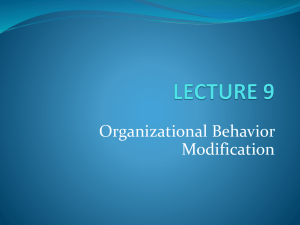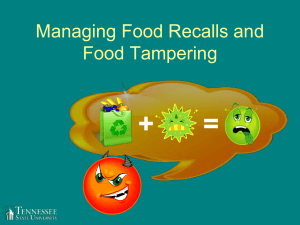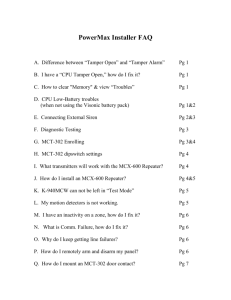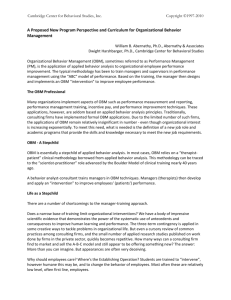DYNAMIC ANALYSIS OF ON-BOARD MASS DATA TO DETERMINE
advertisement
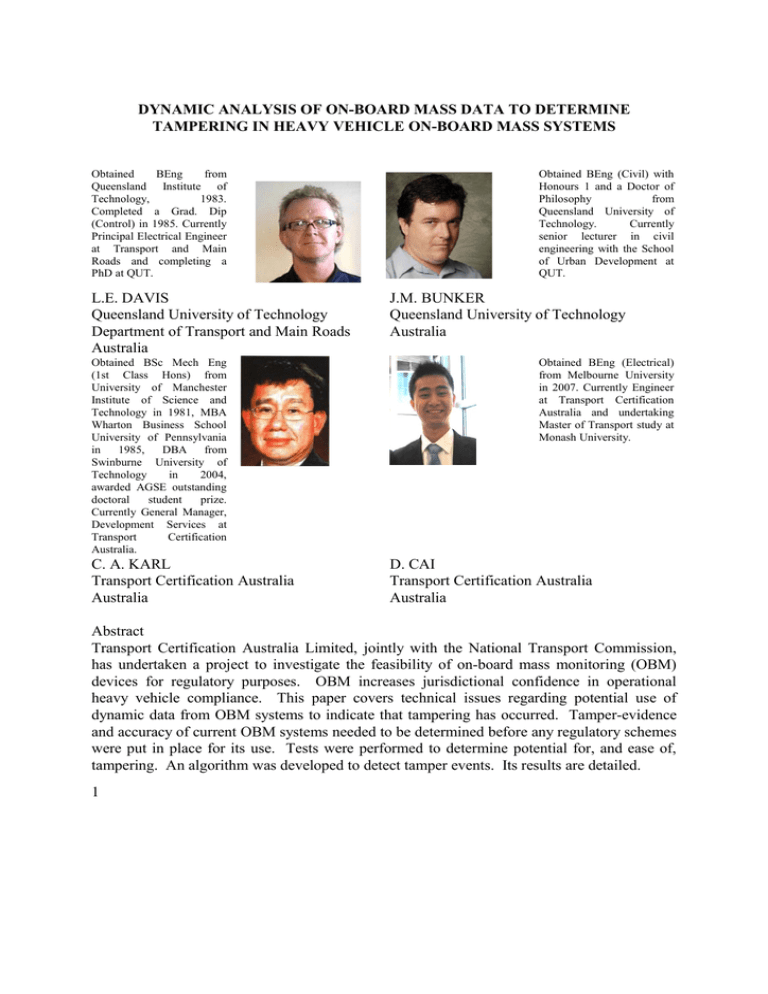
DYNAMIC ANALYSIS OF ON-BOARD MASS DATA TO DETERMINE TAMPERING IN HEAVY VEHICLE ON-BOARD MASS SYSTEMS Obtained BEng from Queensland Institute of Technology, 1983. Completed a Grad. Dip (Control) in 1985. Currently Principal Electrical Engineer at Transport and Main Roads and completing a PhD at QUT. L.E. DAVIS Queensland University of Technology Department of Transport and Main Roads Australia Obtained BSc Mech Eng (1st Class Hons) from University of Manchester Institute of Science and Technology in 1981, MBA Wharton Business School University of Pennsylvania in 1985, DBA from Swinburne University of Technology in 2004, awarded AGSE outstanding doctoral student prize. Currently General Manager, Development Services at Transport Certification Australia. C. A. KARL Transport Certification Australia Australia Obtained BEng (Civil) with Honours 1 and a Doctor of Philosophy from Queensland University of Technology. Currently senior lecturer in civil engineering with the School of Urban Development at QUT. J.M. BUNKER Queensland University of Technology Australia Obtained BEng (Electrical) from Melbourne University in 2007. Currently Engineer at Transport Certification Australia and undertaking Master of Transport study at Monash University. D. CAI Transport Certification Australia Australia Abstract Transport Certification Australia Limited, jointly with the National Transport Commission, has undertaken a project to investigate the feasibility of on-board mass monitoring (OBM) devices for regulatory purposes. OBM increases jurisdictional confidence in operational heavy vehicle compliance. This paper covers technical issues regarding potential use of dynamic data from OBM systems to indicate that tampering has occurred. Tamper-evidence and accuracy of current OBM systems needed to be determined before any regulatory schemes were put in place for its use. Tests were performed to determine potential for, and ease of, tampering. An algorithm was developed to detect tamper events. Its results are detailed. 1 Keywords: Heavy Vehicle, Dynamic Signal, On-board Mass Monitoring, Tamper, Vehicle Telematics. 1. Introduction Transport Certification Australia Limited (TCA) was created to administer the Intelligent Access Program (IAP) and certify HV telematics service-providers who provide IAP Services. Stage 1 of the IAP monitors HV location, time, speed, tamper-evidence and proprietary trailer identification (Karl et al. 2009). TCA, jointly with the National Transport Commission (NTC), has undertaken a project to investigate the feasibility of on-board mass (OBM) monitoring devices to be incorporated into Stage 2 of the IAP (Davis et al. 2008a). OBM increases jurisdictional confidence in operational HV compliance. This paper covers technical issues regarding potential use of dynamic data from OBM systems using air pressure transducer signals to indicate that tampering has occurred. The use of load cell data for a similar purpose has yet to be determined (Karl et al. 2009). Tamper-evidence and accuracy of current OBM systems needed to be determined before any regulatory schemes were put in place for its use. There are no regulatory OBM schemes for HVs operating anywhere in the world. Australia, via the IAP (Davis et al. 2008a; Karl 2007; Karl et al. 2009; Transport Certification Australia 2005) is examining the feasibility of such implementation. Tests were performed to determine potential for, and ease of, tampering. Various tamper tests were performed; the one that concerns this paper directly was where the air lines to the OBM primary transducers were closed off. Dynamic data were recorded for open and closed primary transducer air line states. The two sets of data were compared and an algorithm developed to detect the differences. 1.1 Test methodology The testing program was conducted in line with Davis et al. (2008a; 2008b). Twelve test and control OBM systems from eight suppliers were installed on eleven HVs. The details, differences and brands of the OBM systems have been made anonymous here and in other work (Karl et al. 2009) due to the competitive nature of the OBM industry in Australia. Where APTs were part of the OBM tested, these converted air spring pressure into electrical signals proportional to that pressure. The OBM systems using these primary transducers processed those signals into a reading to indicate the mass of the HV axle group. Some APTtype OBM systems used an algorithm to compute the steer axle mass where that axle did not have a primary transducer for direct measurement. This was done by computing the steer axle mass from the moment of the HV chassis from a reading on the drive group air springs. The HVs were weighed a number of times on weighbridges after a short road circuit as part of the broader test programme (Karl et al. 2009). The suspensions of the tested HVs were exercised between readings to ensure that bushing hysteresis, inter-leaf friction, air bag stretch, etc, were averaged out over the readings. That meant that each test HV was required to perform some travel activity before returning to be weighed again, typically a circuit around a suburban block or within a transport depot. This provided an opportunity to record APT data (where these were fitted) during these circuits. Examples of the tested HVs are shown Figure 1. Davis et al. Dynamic analysis of on-board mass data to determine tampering in heavy vehicle on-board mass systems 2 Figure 1 – Montage of test HVs and dates of testing. 1.2 Sampling frequency It was postulated that dynamic data could inform the development of a tamper indicator. Further to this, it was theorised that signal frequencies of the pressure in the air springs, and influenced by axle-hop, would be key to this development. HV axle-hop occurs at frequencies approximately 10 to 15 Hz (Cebon 1999). For the Nyquist sampling criterion (Shannon’s theorem) to be satisfied, data capture needed to be at least twice the frequency of interest (Houpis and Lamont 1985) or at least 30 Hz. Most commercial OBM systems do not record dynamic data at frequencies that would have allowed axle-hop to be recorded but most manufacturers have stated that their systems would be capable of such measurement, were it required (Davis 2008). Data were recorded during the road circuits. This was with a HV OBM system whose manufacturer had specified a sample interval of 24.0 ms, providing a sampling rate of 41.6 Hz (Davis et al. 2008a; Davis et al. 2008b). Accordingly, the Nyquist sampling criterion (Shannon’s theorem) was met (Houpis and Lamont 1985) for that part of the data gathering during the tests. 2. Tamper tests - detail Controlled tampering during the tests was carried out to determine whether the effects of that tampering could be detected from changes in the data. Accordingly, some basic tampering that involved changing the operation of the test vehicle or its systems occurred. Some tested OBM systems used APTs to determine OBM mass readings from air spring pressure. For those cases, a ball valve or turncock was interposed in the air line between the APT and its associated air springs (Figure 2). This allowed the pressure in the air springs of the axle group being measured (to determine the mass on that group) to be presented to the APT or not. Davis et al. Dynamic analysis of on-board mass data to determine tampering in heavy vehicle on-board mass systems 3 Accordingly, this simulated the case where an operator may block the APT air line in an attempt to provide an OBM system with a false, and lower, group mass than the actual mass (Davis et al. 2008a; Davis et al. 2008b). Figure 2 – Ball value interposed between air spring and APT. 3. Results – analysis of dynamic data for non-tamper events The data sets recorded during the exercising of the HV suspensions is exemplified by the time series in Figure 3. These data sets were recorded, for each test HV for each circuit for each load point, from the air pressure transducers connected to the air springs. Such plots were in alignment with typical HV air spring time series data recorded during travel over typical uneven pavements for other testing programmes (Davis and Bunker 2008). Data from dynamic recording reference OBM system - RHS of HV Air spring reading (kg) 28000 23000 18000 13000 Drive axle RHS air spring Trailer group RHS air spring 28 26 24 22 20 18 16 14 12 10 8 6 4 2 0 8000 Time (s) Figure 3 – Example of dynamic on-board mass data. The dynamic air pressure transducer (APT) data were analysed using a fast Fourier transform (FFT). The frequency spectra at the air springs for all axle groups for all circuits (Davis et al. 2009) were derived. Rectangular FFT windowing was used (Brigham 1988) to analyse the 1248 data points recorded at 41.6 Hz for each dynamic recording as described above. Examples of these FFT plots are shown in Figure 4. The vertical scale used is an arbitrary linear scale. Davis et al. Dynamic analysis of on-board mass data to determine tampering in heavy vehicle on-board mass systems 4 F T o f F s ig n a l 1 0 0 0 9 0 0 9 0 0 8 0 0 8 0 0 a m p lit u d e (a rb it ra ry lin e a r s c a le ) a m p lit u d e ( a r b it r a r y lin e a r s c a le ) F 1 0 0 0 7 0 0 6 0 0 5 0 0 4 0 0 3 0 0 2 0 0 F T o f s i g n a l 7 0 0 6 0 0 5 0 0 4 0 0 3 0 0 2 0 0 1 0 0 1 0 0 0 0 1 1 0 F r e q u e n c y 1 0 ( H z ) 0 0 1 0 1 F r e q u e n c y 1 0 ( H z ) Figure 4 – Example of FFTs results from dynamic on-board mass data. The FFTs in Figure 4, and others derived from the data recorded for this project, indicated that, for healthy suspensions without tampering, the frequency spectra of the air springs had various peaks from 1.0 Hz to 15 Hz. Further, the frequency peaks shown were a combination of vehicle Eigenfrequencies, vehicle geometry, and road surface unevenness. Vehicle Eigenfrequencies are related to vehicle dynamics and include such phenomena as body bounce, body pitch and axle hop. Body bounce is usually in the approximate range of 1 to 4 Hz (de Pont 1997). The pitch mode frequency is usually in the 3 to 4 Hz range (Cole and Cebon 1991; OECD 1998). The axle hop frequency is usually in the 10 to 15 Hz range (Cebon 1999). Other influences that would be manifest in a FFT of air spring data would be where frequency matching between the vehicle Eigenfrequency and the road profile wavelength occurs for a given vehicle speed (OECD 1998). Peaks in the FFT plots shown in Figure 4 correspond to these types of influences. It is not necessary to identify the origin of each peak in the FFT plot in detail any further. This is because the development of the tamper indicators later in this paper is based on the amplitude of the FFT being uneven, comprising peaks and troughs, across the frequency range. 4. Development of tamper metrics Heavy vehicle (HV) regulators regard tampering with vehicle instrumentation or measurement systems, particularly those on HVs, as a major issue. The ball valves were closed to simulate tamper events deliberately designed to prevent detection of correct HV mass while the test HV performed a circuit on typically uneven pavements. Examples of dynamic data recorded for test cases of tampering with the ball valves to the APTs shut are shown in Figure 5. The choice of left or right side, drive or trailer axle data in these figures was not particularly significant; they are presented here as illustrative of typical dynamic data recorded during the tamper testing for all circuits and tested HVs. Davis et al. Dynamic analysis of on-board mass data to determine tampering in heavy vehicle on-board mass systems 5 Figure 5 – Examples of time-series data from on-board mass system when tampering occurred. The plots of the air spring data in Figure 5 indicate that the signal is relatively steady, sometimes declining due to air line leaks and with some small variation due to electronic noise present. They differ markedly from the dynamic data that would be expected from air springs in the time domain such as shown in the time series in Figure 3. The right panel of Figure 5 shows two signals from the drive axle of a test HV where both air lines were leaking. A decline in pressure is apparent approximately 5 seconds after the recording started and before the HV started its test run. Note that the ball valves were turned off at different times for this plot, leading to different starting points for air pressure depletion. Not all air lines in HVs leak; some do and that is a normal condition that is compensated for by the supply of more air from the compressor on the HV. The examples shown were representative and typical of the results from the tamper events where the air lines to the APTs were blocked. Accordingly, both the leaky and the air-tight states of the air lines for the controlled tamper events in the test programme were indicative with respect to the conditions surrounding potential tamper events in the field. Any tamper measure needed to address these. Fast Fourier transforms (FFTs) were applied to the dynamic air pressure transducer (APT) data shown Figure 5. Examples of these FFT plots are shown in Figure 6. Davis et al. Dynamic analysis of on-board mass data to determine tampering in heavy vehicle on-board mass systems 6 F F T o f d y n a m ic O B M s ig n a l F F T o f s ig n a l 1 0 0 0 9 0 0 8 0 0 a m p lit u d e ( a r b it ra r y lin e a r s c a le ) M a g n it u d e o f d y n a m ic O B M s ig n a l ( a rb it r a r y lin e a r s c a le ) 1 5 0 1 0 0 5 0 7 0 0 6 0 0 5 0 0 4 0 0 3 0 0 2 0 0 1 0 0 0 - 1 1 0 0 F 1 0 r e q u e n c y 1 1 0 ( H z ) 0 0 1 0 1 F r e q u e n c y ( H 1 0 z ) Figure 6. Example of FFTs for APT tampering events (LHS is flat line). Rectangular FFT windowing was used (Brigham 1988) to analyse the 1248 data points recorded at 41.6 Hz for each dynamic recording. The vertical scales used in Figure 6 are arbitrary linear scales but are of the same units. The frequency spectra of the air springs when tampering occurred had some distinct and common characteristics, namely: • a smooth transition from maxima at the lower end of the frequency spectrum to minima at the upper end; and • no distinct peaks in the frequency spectrum from physical or mechanical influences on the HV air springs save for a maximum amplitude at the lower end of the spectrum. The FFTs did not alter markedly in their overall shapes or characteristics for the leaky tamper events compared with the non-leaky ones. These FFT results were very likely due to the absence of dynamic signals at the APTs that would be expected at the air springs. As mentioned, these dynamic signals would be from a combination of sources such as road surface signals, pitch modes, HV Eigenfrequencies (OECD 1998), etc. This combination of signals was not evident in any of the FFT outputs from any of the tamper tests. Previous analysis arrived at a similar conclusion (Davis et al. 2009). 5. Tamper indicators Transport industry regulators in Australia would welcome an operational environment where tampering with HV systems did not occur. However, should OBM systems be implemented in a regulatory framework in future, transport industry regulators take the pragmatic view that attempts at tampering will occur. That such a framework is being considered more widely is evident (Clarke and Prentice 2009). Accordingly, reliable tamper-evident metrics are required to indicate tamper events. To detect tampering events, a number of quantitative tampering measures have been developed. This paper provides only the results for one such measure, designated the ‘tampering index’ (TIX). Other tampering metrics are being developed by TCA and the Department of Transport and Main Roads. As is proper, details of these are being kept confidential so that they are not undermined by unscrupulous activity such as reverse Davis et al. Dynamic analysis of on-board mass data to determine tampering in heavy vehicle on-board mass systems 7 engineering being applied to them. Accordingly, a general description of the TIX algorithm and the results of its application are made public here, but specific details are restricted. The tampering index (TIX) is a non-dimensional number and is proposed as one of a range of indicators to be applied to OBM data. These indicators are anticipated as triggers to notify jurisdictions of potential tamper events. The TIX indicator was derived from the range of dynamic data from the OBM system primary transducers. Were the load or the speed to increase, then the range of the dynamic data would be expected to increase as shown in other work in this project (Davis and Bunker 2008). Accordingly, the TIX algorithm normalises the data’s dynamic range so that the TIX values remain within a reasonably constant envelope, irrespective of speed or load. Applying the TIX algorithm to the dynamic data for the non-tamper circuits resulted in a range of values that were indicative of “healthy” operation, i.e. no tampering. Figure 7 shows a graphical representation of this concept by example. Figure 7 – Illustrative plot showing TIX range for dynamic data during typical operation and TIX value during tamper event. The “healthy” range for TIX values is arrowed and between the upper and lower TIX results. In this figure, the TIX tamper value is the lower square. Where the derived TIX values resulted in loci, rather than points of maxima and minima, the healthy range for the TIX values was bounded by those loci. The TIX algorithm was applied to the dynamic data recorded during the test circuits for both the tamper and non-tamper test states. This was to provide TIX values for control data when the HVs were moving without tampering vs. test TIX values derived from the test data cases for tamper events. Thirty-eight instances of tamper vs. non-tamper events were analysed using the TIX algorithm. Three indicative examples for this analysis are plotted in Figure 8 below. Davis et al. Dynamic analysis of on-board mass data to determine tampering in heavy vehicle on-board mass systems 8 Figure 8 – Annotated example of TIX algorithm applied to empirical on-board mass data for typical operation and during tamper event. In all thirty-eight cases, the TIX values for tamper tests were distinct from TIX ranges or areas between the loci for maxima and minima from the non-tamper data (Davis et al. 2009). The TIX algorithm was also applied to data collected from air springs during other testing (Davis and Bunker 2008) that incorporated a range of speeds from urban to highway. The order-of-magnitude of these TIX results remained constant for that range of speeds. This validated the concept of the inclusion of a normalising factor in the TIX algorithm. 6. Discussion 6.1 Tamper metrics - implementation The following logical chain of scenarios derived from the testing in this project may inform Stage 2 of the IAP for implementation of OBM systems on HVs. Given any normal operational scenario for a monitored HV, a number of metrics would be expected to be present, including: movement of the vehicle (detected via GPS tracking capability); Davis et al. Dynamic analysis of on-board mass data to determine tampering in heavy vehicle on-board mass systems 9 frequency spectrum of the dynamic data being characterised as: not smooth; not declining in magnitude with increasing frequency; with multiple peaks and all of them above (say) 1.0 Hz; and tamper index (TIX) within healthy bounds. Were scenarios 1 to 3 (and hence their associated metrics) to be present, then tampering is highly improbable. Some OBM systems have an accelerometer built into their housing. These elements are used by manufacturers to compensate the OBM reading when the HV is parked on a slope. Other applications of accelerometers in OBM modules are used to determine if the HV is on level ground. Both these applications of accelerometers to OBM readings allow the HV operator to make a judgement of the reliability of the OBM readout accuracy or, in more advanced applications, allow the OBM system to correct the raw transducer data before displaying a mass value (Davis 2008). Further to scenarios 1 to 3 above, then, another indicator may be added: 7. dynamic signals from the chassis of the vehicle as it is in motion and as measured by an accelerometer in the OBM unit. Were a combination of scenario 1, above, to be present without scenarios 2 to 4, it is highly likely that tampering has occurred. Other combinations, such as where all or part of scenario 2 or scenario 3 are not present individually but scenario 4 is detected, would indicate a high probability that a tamper event had occurred. Even for basic implementation of tamper-evidence without the multiple verifications of scenarios 1 to 4 (and their associated metrics) above, the simple metrics of: movement of the vehicle, as detected by GPS; dynamic data being present at the chassis; and absence of primary transducer signal (due to blocked air line or cables cut); would be a basic set of conditions that would indicate a high probability of a tamper event. 6.2 Future research The main areas of potential tampering with APTs have been addressed in the test programme and development of both technical and business options to detect these events will need to be addressed for implementation of regulatory OBM system application to Australian HVs. The issue of applying the TIX algorithm developed to detect tampering to load cell data needs to be undertaken. This is because HVs use load cells as well as APTs to determine OBM readings. The issue of tampering with load cells in the static environment has been shown to be of concern (Karl et al. 2009). The TIX algorithm has not yet been validated against corrupted vs. typical load cell data. A modified OBM reference system will need to be used to measure dynamic signals from load cells, before and after they have been wedged, to explore further the validity of the tampering algorithms and any supporting technical and business rules developed. Davis et al. Dynamic analysis of on-board mass data to determine tampering in heavy vehicle on-board mass systems 10 7. Conclusion This paper has presented typical air pressure transducer tamper data from the heavy vehicle OBM testing programme conducted by Transport Certification Australia (TCA). It has expanded on data analysis of the deliberate tampering events during the OBM system testing. A set of tamper indicators was developed and included an algorithm to indicate a tamper event. These indicators and the algorithm have been presented, with some validation. These developments will inform road transport regulators and jurisdictions in the implementation of OBM systems for heavy vehicles (HVs) and may be used for Stage 2 of the Intelligent Access Project. The main areas of potential tampering have now been addressed and development of both technical and business options to detect these events will need to be addressed for implementation of regulatory OBM system application to Australian HVs. Agreed best practice guidelines and procedures for installation, calibration, operation and maintenance, will be developed as TCA moves into the regulatory phase for OBM implementation. The test programme investigated the potential use of additional intelligence derived from analysis of dynamic OBM data as validation against data from the static data recorded by those OBM systems. 8. Acknowledgement The authors would like to express their appreciation to the OBM testing team and ARRB Group staff (including Chris Blanksby, Peter Eady and Anthony Germanchev) that contributed to the testing program and collected data for this paper. 9. References • • • • • • • • Brigham, E. O. (1988). The Fast Fourier Transform and Its Applications, Prentice-Hall, Englewood Cliffs, New Jersey, USA. Cebon, D. (1999). Handbook of Vehicle-Road Interaction, Swets & Zeitlinger, Lisse, South Holland, Netherlands. Clarke, H., and Prentice, D. (2009). "A Conceptual Framework for the Reform of Taxes Related to Roads and Transport." La Trobe University., Melbourne, Victoria, Australia. Cole, D. J., and Cebon, D. (1991). "Assessing the Road-Damaging Potential of Heavy Vehicles." Journal of Automobile Engineering Proc IMechE, 205, 223 - 232. Davis, L. (2008). "Technical Feasibility Assessment of on-Board Mass-Monitoring (OBM) Devices. International Study Tour Report." Queensland Department of Main Roads; Queensland University of Technology; Transport Certification Australia., Brisbane, Queensland, & Melbourne, Victoria; Australia. Davis, L., and Bunker, J. (2008). Suspension Testing of 3 Heavy Vehicles – Methodology and Preliminary Frequency Analysis, Queensland Department of Main Roads; Queensland University of Technology., Brisbane, Queensland, Australia. Davis, L., Bunker, J., and Karl, C. (2008a). "Technical Feasibility Assessment of onBoard Mass-Monitoring (OBM) Devices: A) Accuracy and Robustness B) Ancillary Systems Analysis. Full-Scale Test Plan." Queensland Department of Main Roads; Queensland University of Technology; Transport Certification Australia., Brisbane, Queensland, & Melbourne, Victoria; Australia. Davis, L., Bunker, J., and Karl, C. (2008b). "Technical Feasibility Assessment of onBoard Mass-Monitoring (OBM) Devices: A) Accuracy and Robustness B) Ancillary Systems Analysis. Pilot Test Plan." Queensland Department of Main Roads; Queensland University of Technology; Transport Certification Australia., Brisbane, Queensland, & Davis et al. Dynamic analysis of on-board mass data to determine tampering in heavy vehicle on-board mass systems 11 • • • • • • • Melbourne, Victoria; Australia. Davis, L., Bunker, J., and Karl, C. (2009). "Technical Feasibility Assessment of on-Board Mass-Monitoring (OBM) Devices: A) Accuracy and Robustness B) Ancillary Systems Analysis: Frequency Analysis Report." Queensland Department of Main Roads; Queensland University of Technology; Transport Certification Australia., Brisbane, Queensland, & Melbourne, Victoria; Australia. de Pont, J. J. (1997). "Assessing Heavy Vehicle Suspensions for Road Wear." 95, Transfund New Zealand., Wellington, New Zealand. Houpis, C. H., and Lamont, G. B. (1985). Digital Control Systems Theory, Hardware, Software, McGraw-Hill, New York, New York, USA. Karl, C. (2007). "Project Plan: Technical Feasibility Assessment of on-Board MassMonitoring (OBM) Devices." Transport Certification Australia Major Projects Division., Melbourne, Victoria, Australia. Karl, C., Davis, L., Cai, D., Blanksby, C., Germanchev, A., Eady, P., and Harcourt, R. (2009). "On-Board Mass Monitoring Test Report (Final)." Transport Certification Australia Ltd., Melbourne, Victoria, Australia. OECD. (1998). "Dynamic Interaction between Vehicles and Infrastructure Experiment (Divine)." DSTI/DOT/RTR/IR6(98)1/FINAL, Organisation for Economic Co-operation and Development (OECD). Paris, France. Transport Certification Australia. (2005). "About the Intelligent Access Program." TCA, Melbourne. Davis et al. Dynamic analysis of on-board mass data to determine tampering in heavy vehicle on-board mass systems 12
